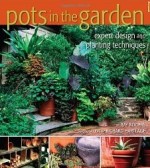 Ray Rogers’ work, Pots in the Garden, is a unique contribution to the large collection of books dealing with container gardening. It contains a wealth of information on all aspects of container gardening from design to execution and stimulates the gardener to go beyond the usual combinations and use of plant material. The book teaches rather than dictates and by so doing fosters understand and promotes creativity.The first section deals with the elements of design but in a new way. Individual sections deal with color, line, repetition, form, mass, texture, focal point, and the appeal of emptiness. After introducing a design element, the author shows how it can be applied to a container using specific plant material. He makes extensive use of color photos that are numbered and discussed by number in the text. Each discussion gives the reader the rational behind design choices and explains alternative solutions to design problems. The reader is often called upon to cover up one or more objects in a photograph in order to visually see the effect of the object in the composition as described by the author, thus engaging the reader in the design process. The discussions teach the reader about the subject matter and develop an understanding that can then be successfully applied to new situations.
Ray Rogers’ work, Pots in the Garden, is a unique contribution to the large collection of books dealing with container gardening. It contains a wealth of information on all aspects of container gardening from design to execution and stimulates the gardener to go beyond the usual combinations and use of plant material. The book teaches rather than dictates and by so doing fosters understand and promotes creativity.The first section deals with the elements of design but in a new way. Individual sections deal with color, line, repetition, form, mass, texture, focal point, and the appeal of emptiness. After introducing a design element, the author shows how it can be applied to a container using specific plant material. He makes extensive use of color photos that are numbered and discussed by number in the text. Each discussion gives the reader the rational behind design choices and explains alternative solutions to design problems. The reader is often called upon to cover up one or more objects in a photograph in order to visually see the effect of the object in the composition as described by the author, thus engaging the reader in the design process. The discussions teach the reader about the subject matter and develop an understanding that can then be successfully applied to new situations.
A second section of the book gathers up the material in the first section to consider the factors that make a design work. An especially appealing, although short, part deals with sensory elements such as motion, sound, fragrance, touch, and taste, and what they can add to the arrangement. The swaying of a vine, clash of bamboo, and roughness of a leaf can all evoke emotions and memoires that enhance our enjoyment of the garden. The basics of container gardening from pot selection and soil preparation to disease control end the section.
Finally attention is turned to plant material according to type: annual, aquatics, bulbs, cacti and succulents, climbers and trailers, perennials, tropical, trees and shrubs. Information is given for each plant about its value as a container plant. For example, Coryline australis adds line and appears to explode from the container; hostas abound in shades of green and interesting textures; hellebors offer early-bloom and eye-catching foliage. When you choose plants using Roger’s list of plants you can choose with reason and logic so as to create a great container.
This book could be a textbook on the art of container gardening. It is not a cookbook for containers and does not have a single recipe. It contains an abundance of pictures, however, that could be easily copied if the reader so desired but that is not the intent of the author. Instead, the book gives the reader a strong background and understanding of the subject matter than can lead gardeners to produce containers according to their personal needs, desires, and taste.
To buy Pots in the Garden: Expert Design & Planting Techniques from Amazon.com click here.